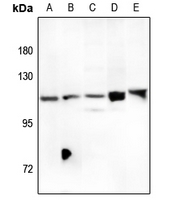Anti-FOXM1 Antibody
- SPECIFICATION
- CITATIONS
- PROTOCOLS
- BACKGROUND

Application
| WB |
|---|---|
| Primary Accession | Q08050 |
| Reactivity | Human, Mouse, Rat |
| Host | Rabbit |
| Clonality | Polyclonal |
| Calculated MW | 84283 Da |
| Gene ID | 2305 |
|---|---|
| Other Names | FKHL16; HFH11; MPP2; WIN; Forkhead box protein M1; Forkhead-related protein FKHL16; Hepatocyte nuclear factor 3 forkhead homolog 11; HFH-11; HNF-3/fork-head homolog 11; M-phase phosphoprotein 2; MPM-2 reactive phosphoprotein 2; Transcription factor Trident; Winged-helix factor from INS-1 cells |
| Target/Specificity | Recognizes endogenous levels of FOXM1 protein. |
| Dilution | WB~~1/500 - 1/1000 |
| Format | Liquid in 0.42% Potassium phosphate, 0.87% Sodium chloride, pH 7.3, 30% glycerol, and 0.09% (W/V) sodium azide. |
| Storage | Store at -20 °C.Stable for 12 months from date of receipt |
| Name | FOXM1 |
|---|---|
| Synonyms | FKHL16, HFH11, MPP2, WIN |
| Function | Transcription factor regulating the expression of cell cycle genes essential for DNA replication and mitosis (PubMed:19160488, PubMed:20360045). Plays a role in the control of cell proliferation (PubMed:19160488). Also plays a role in DNA break repair, participating in the DNA damage checkpoint response (PubMed:17101782). Promotes transcription of PHB2 (PubMed:33754036). |
| Cellular Location | Nucleus. |
| Tissue Location | Expressed in thymus, testis, small intestine, colon followed by ovary. Appears to be expressed only in adult organs containing proliferating/cycling cells or in response to growth factors. Also expressed in epithelial cell lines derived from tumors Not expressed in resting cells. Isoform 2 is highly expressed in testis |

Thousands of laboratories across the world have published research that depended on the performance of antibodies from Abcepta to advance their research. Check out links to articles that cite our products in major peer-reviewed journals, organized by research category.
info@abcepta.com, and receive a free "I Love Antibodies" mug.
Provided below are standard protocols that you may find useful for product applications.
Background
Rabbit polyclonal antibody to FOXM1
If you have used an Abcepta product and would like to share how it has performed, please click on the "Submit Review" button and provide the requested information. Our staff will examine and post your review and contact you if needed.
If you have any additional inquiries please email technical services at tech@abcepta.com.













 Foundational characteristics of cancer include proliferation, angiogenesis, migration, evasion of apoptosis, and cellular immortality. Find key markers for these cellular processes and antibodies to detect them.
Foundational characteristics of cancer include proliferation, angiogenesis, migration, evasion of apoptosis, and cellular immortality. Find key markers for these cellular processes and antibodies to detect them. The SUMOplot™ Analysis Program predicts and scores sumoylation sites in your protein. SUMOylation is a post-translational modification involved in various cellular processes, such as nuclear-cytosolic transport, transcriptional regulation, apoptosis, protein stability, response to stress, and progression through the cell cycle.
The SUMOplot™ Analysis Program predicts and scores sumoylation sites in your protein. SUMOylation is a post-translational modification involved in various cellular processes, such as nuclear-cytosolic transport, transcriptional regulation, apoptosis, protein stability, response to stress, and progression through the cell cycle. The Autophagy Receptor Motif Plotter predicts and scores autophagy receptor binding sites in your protein. Identifying proteins connected to this pathway is critical to understanding the role of autophagy in physiological as well as pathological processes such as development, differentiation, neurodegenerative diseases, stress, infection, and cancer.
The Autophagy Receptor Motif Plotter predicts and scores autophagy receptor binding sites in your protein. Identifying proteins connected to this pathway is critical to understanding the role of autophagy in physiological as well as pathological processes such as development, differentiation, neurodegenerative diseases, stress, infection, and cancer.


